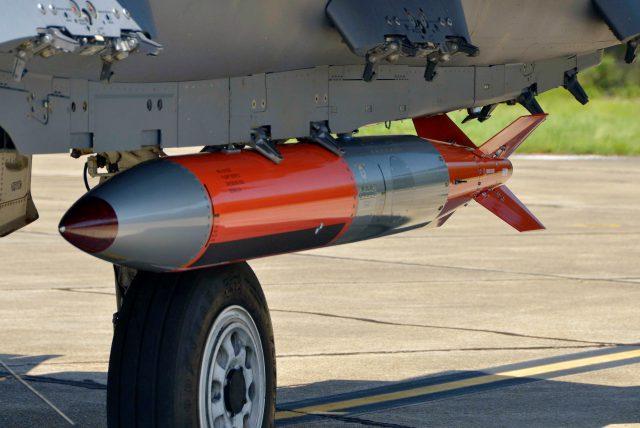Back to the future with mini-nukes?
Posted By Malcolm Davis on September 21, 2017 @ 14:30

In 2003, the Bush administration caused a furore by proposing a new type of nuclear weapon, formally called the ‘Robust Nuclear Earth Penetrator’ (RNEP), to defeat hard and deeply buried targets. The term ‘mini-nuke [1]’ quickly became associated with the plan because of the ‘dial-a-yield’ feature of the design. Critics contended that the mini-nuke with lower yields blurred the distinction between conventional and nuclear war and made the use of nuclear weapons more likely. It was a return to Cold War–style tactical weapons, like Davy Crockett [2] (a nuclear recoilless gun whose 20-ton TNT equivalent yield generated a lethal radiation zone that exceeded its launch range).
The trend towards lower-yield weapons has continued. In 2016, the US began development of the B61-12, which has a precision glide capability comparable to the conventional Joint Direct Attack Munition (JDAM), delivering accuracy of around 30 metres. Once again, it has dial-a-yield feature, with a lowest setting of 0.3 kilotons (300 tons), and it has an earth-penetrating capability [3]. So, with the B61-12, RNEP lives, and once again this raises the issue of enhanced usability [4].
Since the end of the Cold War, Washington’s attention to nuclear strategy has waned. Nuclear weapons have tended to be seen in the West in the context of arms control and disarmament. That stance was bolstered by the increasingly strident efforts of proponents of abolition and nuclear ‘global zero [5]’ to rid the world of nuclear weapons, off the back of President Obama’s 2009 Prague [6] speech:
So today, I state clearly and with conviction America’s commitment to seek the peace and security of a world without nuclear weapons. This goal will not be reached quickly—perhaps not in my lifetime. It will take patience and persistence. But now we, too, must ignore the voices who tell us that the world cannot change.
Obama added a caveat to this soaring rhetoric, noting that ‘as long as [nuclear] weapons exist’, the US would ‘maintain a safe, secure and effective arsenal to deter any adversary, and guarantee that defense to our allies’.
Neither Russia nor China seems ready to jump on the abolitionist bandwagon, as they are too busy with nuclear force modernisation of their own. Nor do the Indians or the Pakistanis, who nervously point their nuclear weapons at each other. Clearly, denuclearisation is the last thing on Kim Jong-un’s mind, and the Iranians, having reaped the financial benefits of the Joint Comprehensive Plan of Action [7], still have their nuclear option in their back pocket when the deal sunsets in 2025. In the interim, they can continue to collaborate [8] on nuclear weapons technology and missile systems with North Korea.
In contrast, US nuclear forces are ageing [9] out. If we want a credible nuclear deterrent for an uncertain future, it’s clear that capability development must proceed. The modernisation of tactical nuclear weapons such as the B61-12 must go hand in hand with strategic force development, including replacing the Minuteman III ICBM, building sufficient numbers of B-21 Raider bombers to make it an effective capability, and proceeding with the Columbia-class submarines that will replace Ohio-class boomers.
We must also get serious about nuclear strategy again, by re-emphasising deterrence as the basis for nuclear force development rather than seeing nuclear weapons through the prism of arms control only. Deterrence works by preventing an opponent from acting in a manner inimical to our interests. If nuclear deterrence is effective, weapons don’t need to be used. That in turn demands a high degree of assurance that nuclear forces are in fact usable. Deterrence isn’t about bluffing. We shouldn’t recoil from discussing nuclear warfighting in the context of reinforcing deterrence, because to proceed under the illusion that deterrence doesn’t imply credible, usable forces misconstrues the concept. Mini-nukes and the B61-12 make sense if they reinforce deterrence credibility and thus make nuclear war less likely.
With that thought in mind, there has been growing interest in the Trump administration’s new Nuclear Posture Review, which is reportedly considering a greater focus [10] on the use of mini-nukes, particularly as a counter to Russia’s pre-emptive de-escalation doctrine [11] (i.e. ‘escalate to win’). It’s unclear [10] whether that would involve new nuclear weapons, with the potential requirement for new nuclear testing, or an intent to work towards operational deployment of the B61-12. But much of the critical commentary has focused on such weapons being usable because they imply lower yields. Critics refer to a recent Defence Science Board report [12] that advocates offering the president ‘rapid, tailored nuclear options for limited use should existing non-nuclear or nuclear options prove insufficient’ (PDF, p. 24). That seems to imply a return to limited nuclear war. Groeteschele [13] notes in Fail-Safe that limited nuclear war is ‘not theoretical’. We’ve never fought one, but we do real planning for such an eventuality, and for good reason.
Having options beyond immediate surrender or suicidal all-out thermonuclear war is logical. The question of whether a limited nuclear war could be fought remains unanswered, but embracing an illusion epitomised by nuclear taboos leaves us unprepared for a more dangerous future. Discussion of mini-nukes and limited options represents a return to thinking about nuclear strategy and how it will drive future capability. That is a welcome step.
Article printed from The Strategist: https://aspistrategist.ru
URL to article: /back-to-the-future-with-mini-nukes/
URLs in this post:
[1] mini-nuke: https://fas.org/faspir/2001/v54n1/weapons.htm
[2] Davy Crockett: https://en.wikipedia.org/wiki/Davy_Crockett_(nuclear_device)
[3] earth-penetrating capability: https://fas.org/blogs/security/2016/01/b61-12_earth-penetration/
[4] enhanced usability: https://fas.org/blogs/security/2015/11/b61-12_cartwright/
[5] global zero: https://www.globalzero.org/
[6] Prague: https://www.youtube.com/watch?v=uYcAr0ZDSlg
[7] Joint Comprehensive Plan of Action: http://collections.internetmemory.org/haeu/content/20160313172652/http:/eeas.europa.eu/statements-eeas/2015/150714_01_en.htm
[8] collaborate: http://thediplomat.com/2017/05/a-closer-look-at-iran-and-north-koreas-missile-cooperation/
[9] ageing: http://foreignpolicy.com/2017/03/17/americas-nuclear-weapons-infrastructure-is-crumbling-national-nuclear-security-administration-deterrence-aging-congressional-oversight/
[10] greater focus: http://www.politico.com/story/2017/09/09/trump-reviews-mini-nuke-242513
[11] de-escalation doctrine: https://www.realcleardefense.com/articles/2017/04/28/russian_nuclear_weapons_policy_111261.html
[12] report: http://www.acq.osd.mil/dsb/reports/2010s/Seven_Defense_Priorities.pdf
[13] Groeteschele: http://www.imdb.com/title/tt0058083/
Click here to print.